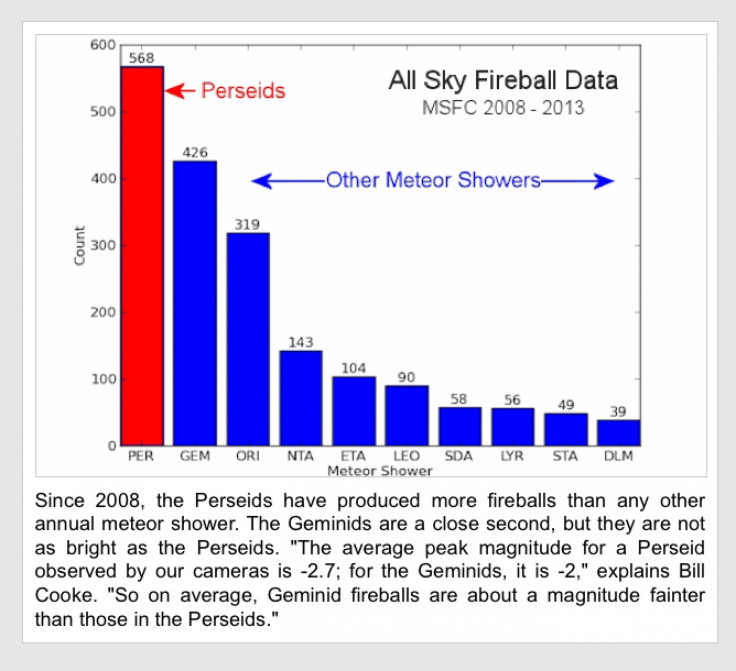Perseid Meteor Shower The ‘Fireball Champion’ Of All Annual Celestial Events: NASA [VIDEO]

Many amateur astronomers believe the Perseid meteor shower is the best sky-watching event year in and year out, and a few professionals at NASA recently crunched the numbers proving they have good reason to think so, Science@NASA said Friday.
“We have found that one meteor shower produces more fireballs than any other,” said Bill Cooke of NASA’s Meteoroid Environment Office. “It’s the Perseid meteor shower, which peaks on August 12th and 13th [this year].”
According to the U.S. space agency: “A fireball is a very bright meteor, at least as bright as the planets Jupiter or Venus. They can be seen on any given night as random meteoroids strike Earth’s upper atmosphere. One fireball every few hours is not unusual. Fireballs become more numerous, however, when Earth is passing through the debris stream of a comet. That’s what will happen this August.”
The Perseid meteor shower is a derivative of the Comet Swift-Tuttle. In early to mid-August each year, Earth passes through a cloud of dust produced by the comet as it approaches the Sun. As a result of this pass through the debris stream, Perseid meteoroids hit the atmosphere at 132,000 mph -- and in significant numbers.
Cooke’s team has employed NASA’s All Sky Fireball Network of meteor cameras across the southern U.S. to track fireball activity since 2008, which has enabled it to build a database of hundreds of events to analyze. And the analysis points to the Perseids as the so-called fireball champion of annual meteor showers.
The Perseid meteor shower is likely rich in fireballs because of the size of the parent comet, Cooke indicated. “Comet Swift-Tuttle has a huge nucleus, about 26 kilometers in diameter,” he said. “Most other comets are much smaller, with nuclei only a few kilometers across. As a result, Comet Swift-Tuttle produces a large number of meteoroids, many of which are large enough to produce fireballs.”
Cooke recommended sky watchers look for the Perseids on the nights of Aug. 12-13 between 10:30 p.m. and 4:30 a.m. local time. He suggested the meteor rate will begin low and then increase until peaking before sunrise when the constellation Perseus is high in the sky. “In total, the Perseid meteor rate from dark-sky sites could top 100 per hour,” NASA said.
As is the case with almost all celestial events in the night sky, light pollution is a key factor while viewing the Perseid meteor shower. Therefore, Cooke said: “Get away from city lights. While fireballs can be seen from urban areas, the much greater number of faint Perseids is visible only from the countryside.”
© Copyright IBTimes 2024. All rights reserved.












